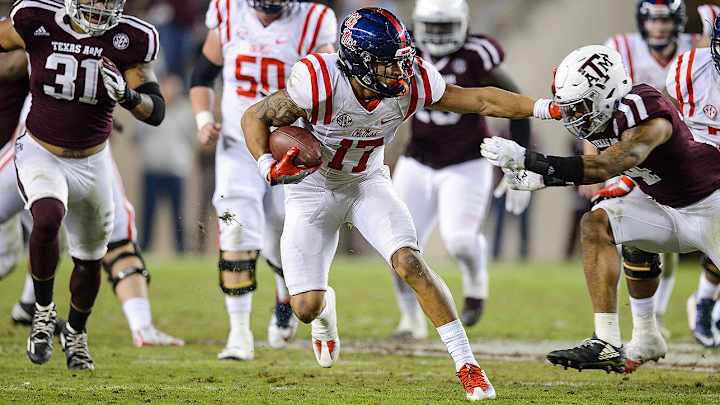2017 NFL draft prospect countdown, No. 27: Evan Engram, TE, Ole Miss

What you need to know: Engram finished out his Ole Miss career by nabbing a First-Team All-America spot, thanks to his impressive 65 catches, 926 yards and eight touchdowns in 2016—he found the end zone against the likes of Florida State, Alabama, Georgia and Auburn. His career totals of 162 receptions and 2,320 receiving yards blew away the Rebels’ previous program records at the tight end position. His career-best performance, yardage-wise, came back in 2014, when he hung 178 yards on Mississippi State. He needed just five receptions to do so, too—a 35.2 yards-per-catch clip. For his career, Engram averaged 14.3 yards per reception.
Strengths: Much the way DE/OLB or S/CB hybrids have helped blur the lines of traditional football positions on defense, players like Engram are making it happen on offense. He may be more slot receiver than tight end, even though the latter is—for the time being—his official position.
No tight end topped Engram’s 4.42-second 40-yard dash at the scouting combine. And just four wide receivers bested that numbers: John Ross, Curtis Samuel (who walks the line between WR and RB), Josh Malone and KD Cannon, all of whom come with the reputation for being explosive, game-breaking players.
Engram’s speed and explosiveness are hard to defend, regardless of where he lines up or whether a linebacker, safety or even cornerback draws the assignment.
Draft This Dude: Evan Engram is 2017's forgotten top-tier tight end
“This [tight-end] class is so deep. All these guys bring a lot to the table,” Engram said. “But for myself, just being able to do anything—be split out, flexed out, get down field in the vertical game, and then have the tenacity to get in and get physical as well. I definitely see myself as a total package, and definitely a threat down field in the vertical passing game.”
As he said, he can be played in just about any spot. Ole Miss most often bumped him out into the slot, but he did see reps inline, wide and even motioning out of the backfield. For a lesser player, that movement might go down as a bit of a gimmick. Engram, though, shows enough development as a route runner to be dangerous from wherever he’s stationed. He will test defenses downfield, but he also has the wherewithal to find soft spots underneath and provide a target for his QB.
Engram wastes little time in his breaks, especially when he turns toward the boundary. He whips his hips and his head around so he is available as early as possible. After the catch, he then can take off.
Weaknesses: Most of the reasons Engram profiles more as a receiver are positives. The glaring negative is that he doesn’t block like a tight end, at least not to the point where an NFL team would want to lean on him in the run game. He has the athleticism and willingness to at least be a serviceable blocker, but he probably has to be used more as an H-back than a tight end.
There are the typical issues under this heading, for a soon-to-be rookie: Engram has to continue to refine his routes and will need to be more aggressive against physical DBs. Almost all of the challenge projecting him to the next level, though, comes in figuring out exactly where his NFL team will play him.
NFL player comparison: Jordan Reed

Chris Burke covers the NFL for Sports Illustrated and is SI.com’s lead NFL draft expert. He joined SI in 2011 and lives in Ann Arbor, Mich.